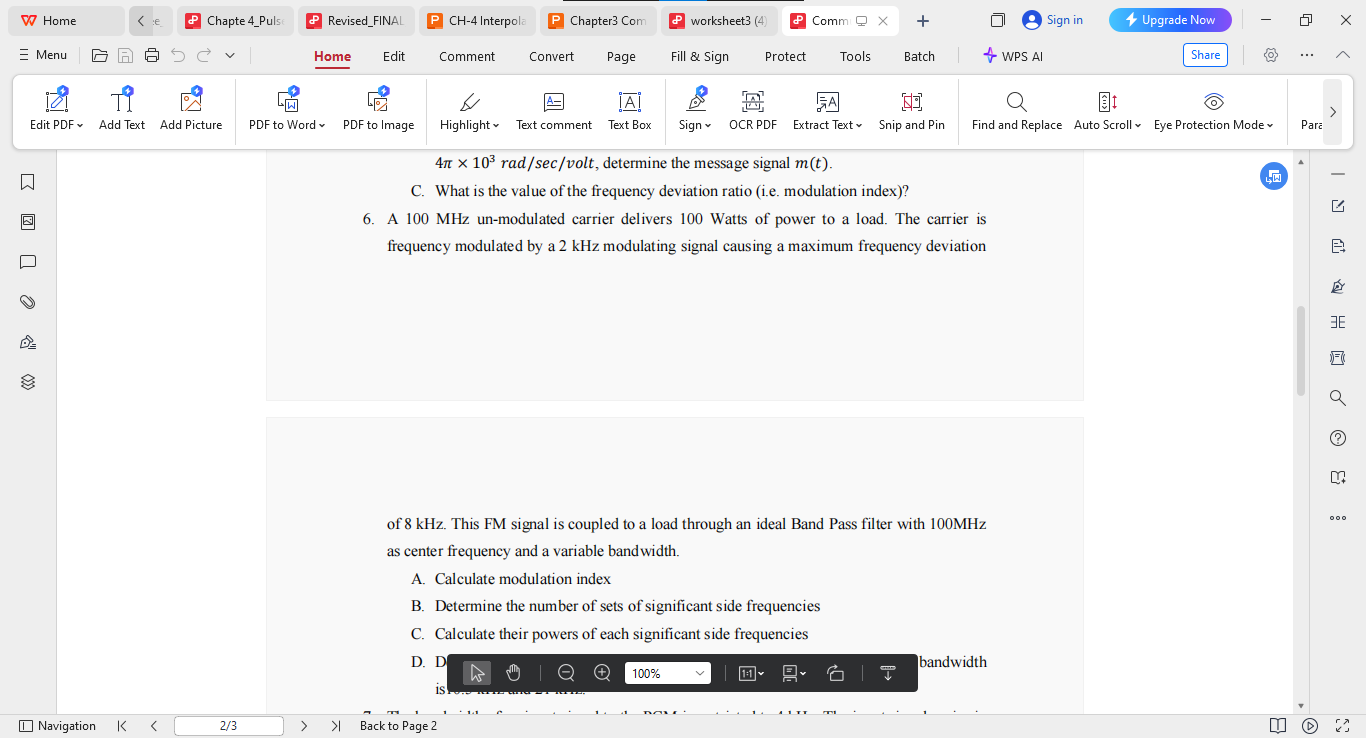A 100 MHz un-modulated carrier delivers 100 Watts of power to a load. The carrier is frequency modulated by a 2 kHz modulating signal causing a maximum frequency deviation of 8 kHz... A 100 MHz un-modulated carrier delivers 100 Watts of power to a load. The carrier is frequency modulated by a 2 kHz modulating signal causing a maximum frequency deviation of 8 kHz. This FM signal is coupled to a load through an ideal Band Pass filter with 100MHz as center frequency and a variable bandwidth. Calculate the modulation index. Determine the number of sets of significant side frequencies. Calculate their powers of each significant side frequencies. Determine the bandwidth of the FM signal if the bandwidth is less than 15 kHz.

Understand the Problem
The question is asking for several calculations related to frequency modulation, including the modulation index, the number of significant side frequencies, and their respective powers. It also asks for the determination of the bandwidth of the signal under given conditions.
Answer
- Modulation index \( m = 4 \), significant side frequencies = 9, bandwidth \( BW = 20 \, \text{kHz} \)
Answer for screen readers
- Modulation index ( m = 4 )
- Number of significant side frequencies = 9
- Powers of significant side frequencies:
- ( P_1 = 100 , \text{W} ),
- ( P_2 = 25 , \text{W} ),
- ( P_3 = 11.11 , \text{W} ),
- ( P_4 = 6.25 , \text{W} )
- Bandwidth ( BW = 20 , \text{kHz} )
Steps to Solve
-
Identify Given Values
- Carrier frequency, ( f_c = 100 , \text{MHz} = 100 \times 10^6 , \text{Hz} )
- Modulating frequency, ( f_m = 2 , \text{kHz} = 2000 , \text{Hz} )
- Maximum frequency deviation, ( \Delta f = 8 , \text{kHz} = 8000 , \text{Hz} )
-
Calculate Modulation Index
- The modulation index ( m ) is calculated using the formula: $$ m = \frac{\Delta f}{f_m} $$
- Substituting the values: $$ m = \frac{8000 , \text{Hz}}{2000 , \text{Hz}} = 4 $$
-
Determine Number of Significant Side Frequencies
- The number of significant side frequencies can be determined using: $$ n = 2m + 1 $$
- For ( m = 4 ): $$ n = 2(4) + 1 = 9 $$
-
Calculate Powers of Significant Side Frequencies
- The power of each side frequency ( P_n ) is given by: $$ P_n = \frac{P_c}{(n^2)} $$
- Where ( P_c = 100 , \text{Watts} ):
- For significant frequencies, we take ( n = 1 ) to ( n = 4). Calculate:
- ( n = 1: P_1 = \frac{100}{1^2} = 100 , \text{W} )
- ( n = 2: P_2 = \frac{100}{2^2} = 25 , \text{W} )
- ( n = 3: P_3 = \frac{100}{3^2} = 11.11 , \text{W} )
- ( n = 4: P_4 = \frac{100}{4^2} = 6.25 , \text{W} )
- For significant frequencies, we take ( n = 1 ) to ( n = 4). Calculate:
-
Determine Bandwidth of the FM Signal
- The bandwidth ( BW ) can be calculated with Carson's Rule: $$ BW = 2(\Delta f + f_m) $$
- Substituting the values: $$ BW = 2(8000 , \text{Hz} + 2000 , \text{Hz}) = 2(10000, \text{Hz}) = 20000 , \text{Hz} = 20 , \text{kHz} $$
- Modulation index ( m = 4 )
- Number of significant side frequencies = 9
- Powers of significant side frequencies:
- ( P_1 = 100 , \text{W} ),
- ( P_2 = 25 , \text{W} ),
- ( P_3 = 11.11 , \text{W} ),
- ( P_4 = 6.25 , \text{W} )
- Bandwidth ( BW = 20 , \text{kHz} )
More Information
The modulation index gives insight into how much the modulating signal affects the carrier frequency. The calculated bandwidth indicates how much frequency space is occupied by the FM signal.
Tips
- Confusing modulation index with frequency deviation; remember that the modulation index is a ratio of deviation to modulating frequency.
- Forgetting to account for all significant side frequencies when calculating power. Ensure all frequencies are taken into account.
AI-generated content may contain errors. Please verify critical information